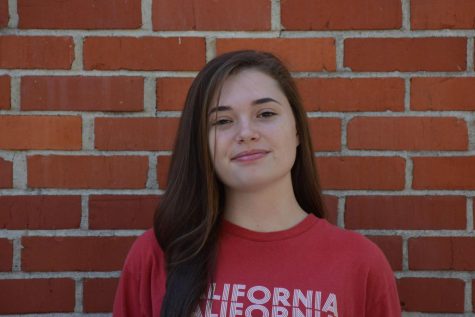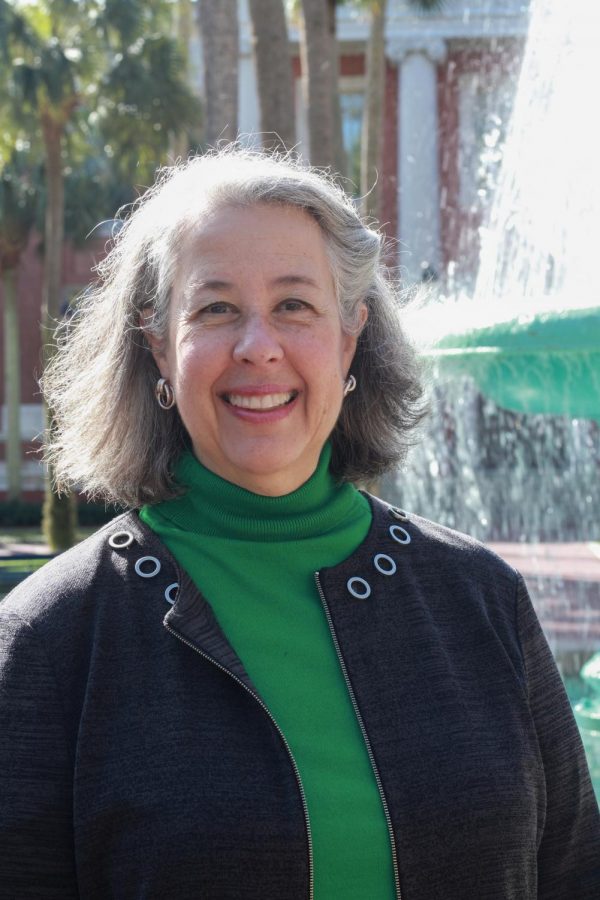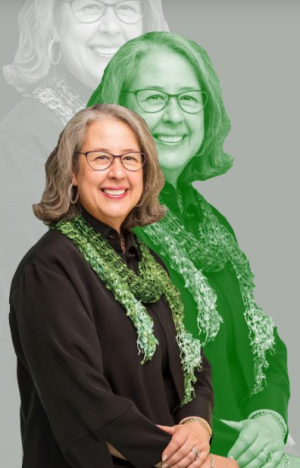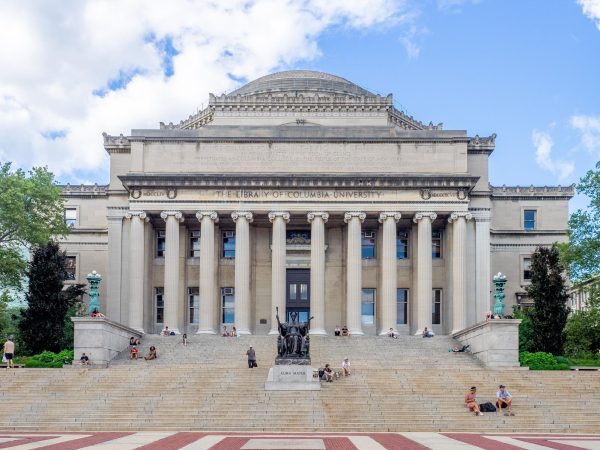Sitting Down With Wendy Libby
Inducted in July 2009, Wendy Libby, Ph.D. became the ninth President of Stetson University and the first female President in the school’s history. Under her presidency, the school brought back the football program after a 57-year hiatus, opened and renovated several facilities such as the Rinker Welcome Center, the Sandra Stetson Aquatic Center, and the expanded Carlton Union Building (CUB), and increased the university’s endowment to nearly $246 million. Her next challenge? Retirement. We sat down with President Libby to discuss her vision for the university during her time at Stetson, and what she hopes for the future of our school and her community.
When you started what was your initial vision for Stetson?
“I always thought that my job here was to leave Stetson better then I found it, which I know is a pretty broad vision. So that means to make sure that our academic program continued to be as rigorous and capable as it’s always been, ‘cause that is why people really come here, and I always felt that people were missing how strong our academic program is because we looked physically so untidy, and when you go somewhere you judge the quality of it –whether that’s a good thing or not – by your first impressions. And my first impression was that this was a campus that had some hidden beauty that just needed to be crisper. What I think we’ve learned is that although some people thought that was kind of a hair-brained scheme, the families that come see that as the proxy of the quality of the academics. So part of my vision, to get back to your question, was to make sure that we did everything to [make the campus] as beautiful as we could and to help the people that work here everyday have more pride in their institution. Also I guess the other thing that was really important to me was to take a place that spans 150 miles across Florida and help it feel like it was one university, and we’ve come very far to make it feel like the undergraduate university in DeLand and the law school in Gulfport feel like they’re one. That the vision- the values of the institution are in harmony with each other.”
Over the years what initiatives have you tried to put in place? What worked and what’s fallen through?
“I would say that we’ve worked very hard on supporting inclusion and equity for our students, staff, and faculty. We probably have made it halfway along and we, as well as this community and this country, probably still have a long way to go to have every person feel valued and to have an opportunity to speak their thoughts and have them be respected. Maybe not agreed with, but be respected. So we still have work to do on that one. The Institute for Water and Environmental Resilience (IWER) that we started a bunch of years ago and is pretty much headquartered out of the Sandra Stetson Aquatic Center over on the lake, I’m especially proud of that, cause it has focused people’s attention on the outstanding work our faculty and student researchers are doing on the quality and quantity of water here in Florida, and trying to maintain healthiness in our aquifers; and are now contributing to policy around the state. So there’s plenty of more work to be done there, but I believe we’ve established ourselves as a foremost important institution in that conversation, and the newly named Chief Resilience Officer for the state is one of our graduates and thankfully she’s already in conversations with Dr. Jason Evans and others about what we do can inform that state to make it a healthier place. I would also say that in some ways we’ve become more student centered. We’ve always been student centered through our academic program, but we have built out the framework through our Hollis Family Student Success Center through club sports, enhanced opportunities for student engagement. Our campus Career and Professional Development group is much stronger, and I love the fact that we’ve added some athletics teams that have had quite a bit of success.
The value of sports – there are some people who are detractors in that regard – but for me it’s another way for our students to learn leadership skills, teamwork, bond to one another, and bring us some positive PR in the places we travel. Our football team for example, plays in San Diego, Des Moines, outside of Charlotte, and we play schools that are quality comprehensive universities like we are, and our name wasn’t in the mix before but having us integrate has been really helpful. Just like having beach volleyball make it to the nationals last year, and having our baseball team go to the super regionals for the first time, or even what’s going on in men’s basketball right now where we’ve come from the cellar and now we’re third in the conference. For people, although it sounds frivolous, it’s no more frivolous than what our student government does, or what mock senate does, they all make this a university. So I’m very pleased that we’ve been able to grow in that regard.
Were there any defining moments during your administration that changed your vision?
“In the fall of 2015, we brought in the largest undergraduate class in Stetson’s history and I remembered back on how we do a visit day and 50 or 60 people would show up and I thought, we’re just not hitting it right. People are not getting why this is a place they should fall in love with, and so that day in convocation when I saw that class, which I think was larger than we needed [laughs], you know we’re never sure who’s gonna show up. Even if people give deposits you’re still never sure, and I just thought: we’ve turned a corner here. It was an important day. Then having them graduate, the largest graduating class ever this past May, was another one of those ‘hm, this is a good thing’ kind of moments. There are others, the law school for example, has been in the middle of the worst market for law students ever in this country, with a drop in nearly fifty percent in LSAT takers, and nevertheless we have hit our budgets for students and we have managed to be smaller in a super competitive market and still stay number one in trial advocacy and increased the quality of our entering class; and that was the moment I said ‘Okay..we’re doing it.’ Lastly, I must say that there have been days –when we opened new buildings, the one we’re sitting in [Rinker Welcome Center], the CUB, starting the first day of football– where I knew that this was good. Another important thing was the gala we held in the CUB homecoming weekend where we announced we raised $218 million to help support the university, on a $200 million goal. Just standing up there and being able to tell everyone about the success they had contributed too, that was another wow moment.”
What is your vision for Stetson past your presidency?
“You know, it’s really not my job to have a vision for Stetson in the future, other than hope that I’ve left the strongest university I can to Dr. Roellke. I mean you step into a river and he’s gonna step into a different piece of the river, and he’s gonna have other ways he wants to take the institution and things he’s going to want to stress that maybe weren’t as important to me. You hire a president to have that vision, so I just want success for this place. We deserve to be successful, we deserve to be excellent, and I’m just here to give him whatever help he wants.”
Regarding the recent increases in tuition, what is the school doing to be more affordable to low-income families?
“Well, that’s a very complicated and long question because you have to have a lot of financial experience to understand the twist and turns of that. So last year the increase in medical insurance costs went up 15 percent, and we buy a basket of goods here that’s mostly people, and so we can’t ignore the fact that they are also looking for increases. So we have to be able to raise tuition to be able to cover things like that. However, what you don’t see is the increase we make in financial aid that offset, so the real issue around price is that the price that we charge is not necessarily related to the price students pay, and that’s just the way this marketplace is. It’s crazy that colleges don’t all lower their tuition to what they expect to be paid. So we can actually lower tuition, but as a result students would receive less financial aid. The net cost for the family doesn’t change, so the whole issue of raising price has a lot to do with competitiveness and market position. The important question is what does it actually cost a family and by improvements in financial aid for our entering students every year, we try to improve the package. For us to be able to deliver an education that you can get out in four years through the Stetson Promise, and have a 91 percent placement in graduate school, there’s value to that as well.
What is the tuition money going towards?
“I mean, there are certainly buildings that are not totally paid for by donors, so for the CUB for example, we took out some borrowing for that. But the Rinker Welcome Center, the volleyball pavilion, the aquatic center, the new golf space, are totally paid for by donors. It’s harder to get donors to pay for academic buildings, but we just received an $18 million dollar gift for our new Cici and Hyatt Brown Hall for Health and Innovation, which we will break ground for in May and start construction in January. So they will pay for that building to go up. But what people don’t see is that we’ve gone from budgeting nothing, like zero, every year for improvement of our facilities. In other words, wait till the end of the academic year and wait to see if you have money left over– and if you do, spend it on making sure your air conditioning works, that you have a new carpet and so on. We’ve gone from budgeting zero to budgeting over seven million dollars a year to keep things working. So, that money does come through the tuition budget but it enables us to paint our classrooms, recarpet them, and put in new bathrooms.”
Will changes be made to allow for more room in housing?
“Yeah, there’s a lot of things going on in housing, but it also really depends on Dr. Roellke’s opinion. So there is a group talking with some of my staff as well as some of the alumni about the trends in how fraternities live, study, and play on campuses and it is not necessarily with each of them in their own house. And that’s not to say that’s what we go to. We just know that we need to go something, that it’s not the best environment for non-fraternity men to be living in fraternities. What we normally budget for, and we’re very fortunate for cause we normally get it, is about 101 percent occupancy in the fall, because we know that in the first two weeks of the semester we’ll be fine. Certainly, those first two weeks there’s a lot more tripling up then we would prefer. What we also know is that in spring term we’re not at 100 percent occupancy and that’s why we put in a program for next year– for those students that will start with us overseas and come back to us in spring term when we have housing availability- but it will offload their needs for housing in the fall. So there’s quite a few things going on. We buy housing, we prefer not to build it, but we buy whatever we can in the market and mostly little townhouse complexes and there are not many left that are walking distance but we have our eye on whatever’s available. When you look out, [on the Stetson green] there used to be a residence hall right there that was a bigger floor plan than the library and was about three or four stories. However, it was wood and I didn’t feel it was safe. It had mold and it couldn’t carry the electrical load because of our computers and microwaves and so on. So we took it down for safety reasons and someday somebody’s gonna have to decide whether it’s worth it to put something out there again, but I’m not gonna make the decision cause I like the green just the way it is. [laughs]
Interview has been edited for grammar and clarity

Lauren is a designer and local news writer for Hatter Network. She is a mass communications major and hopes to become a mass media analyst after she graduates....






